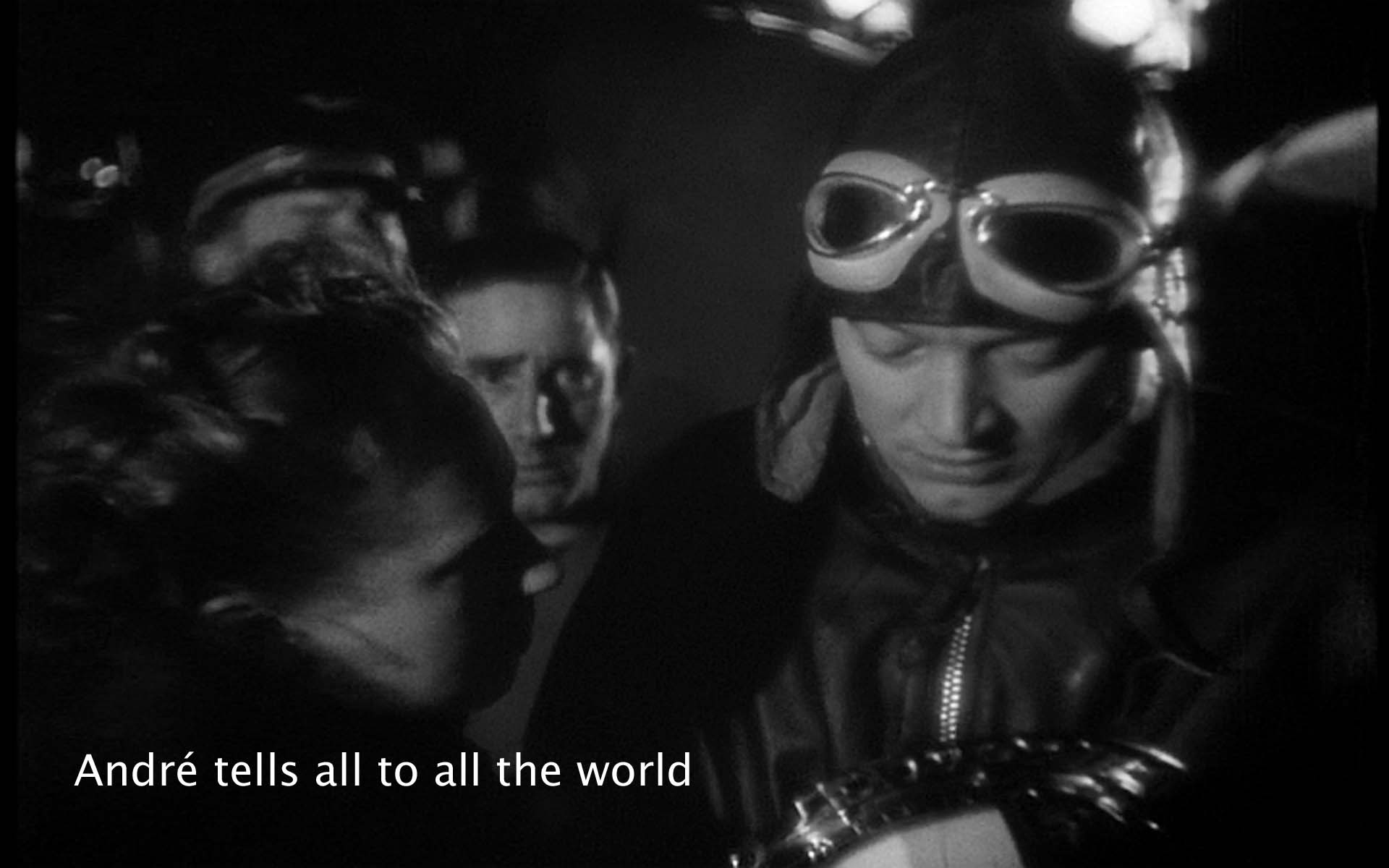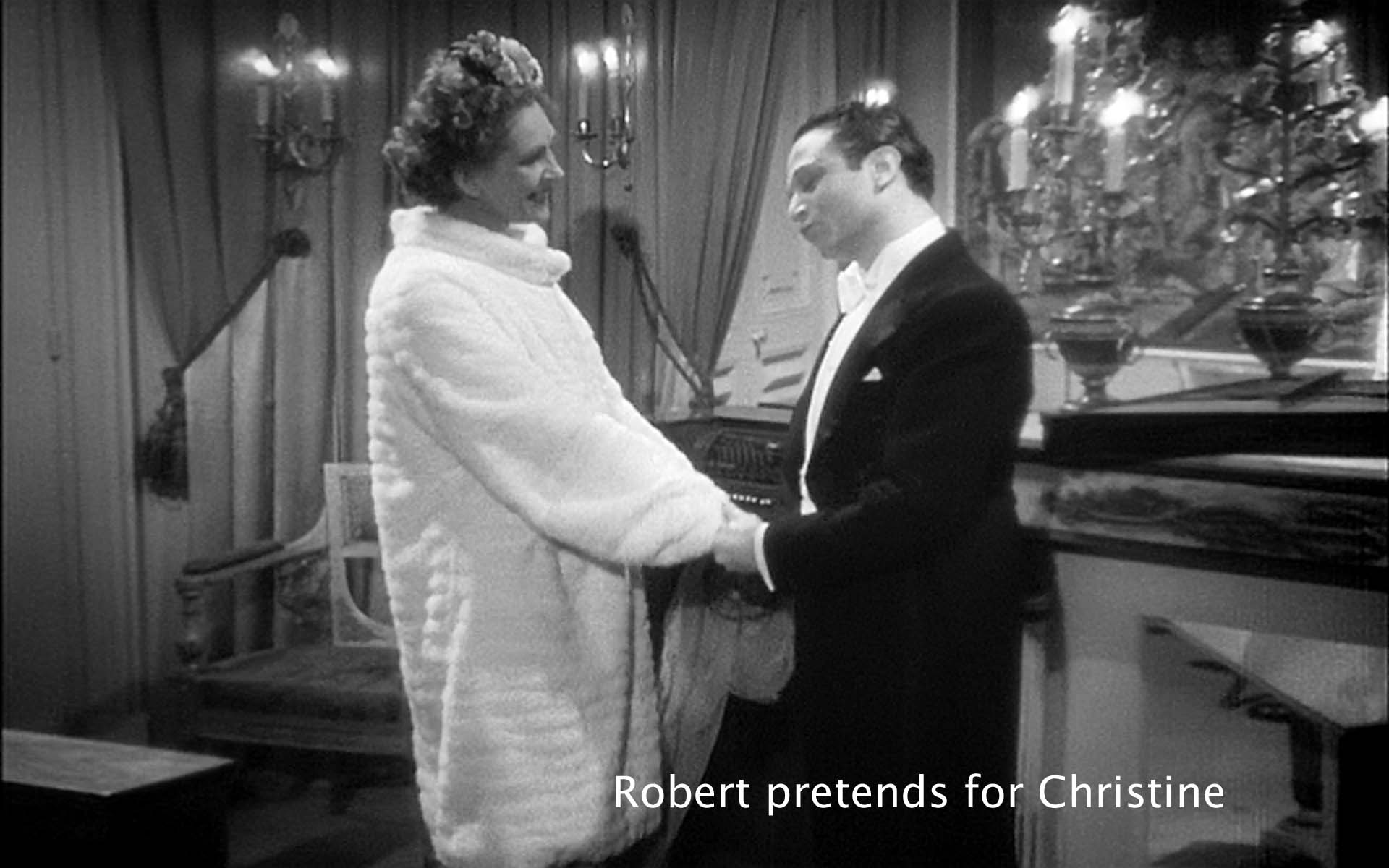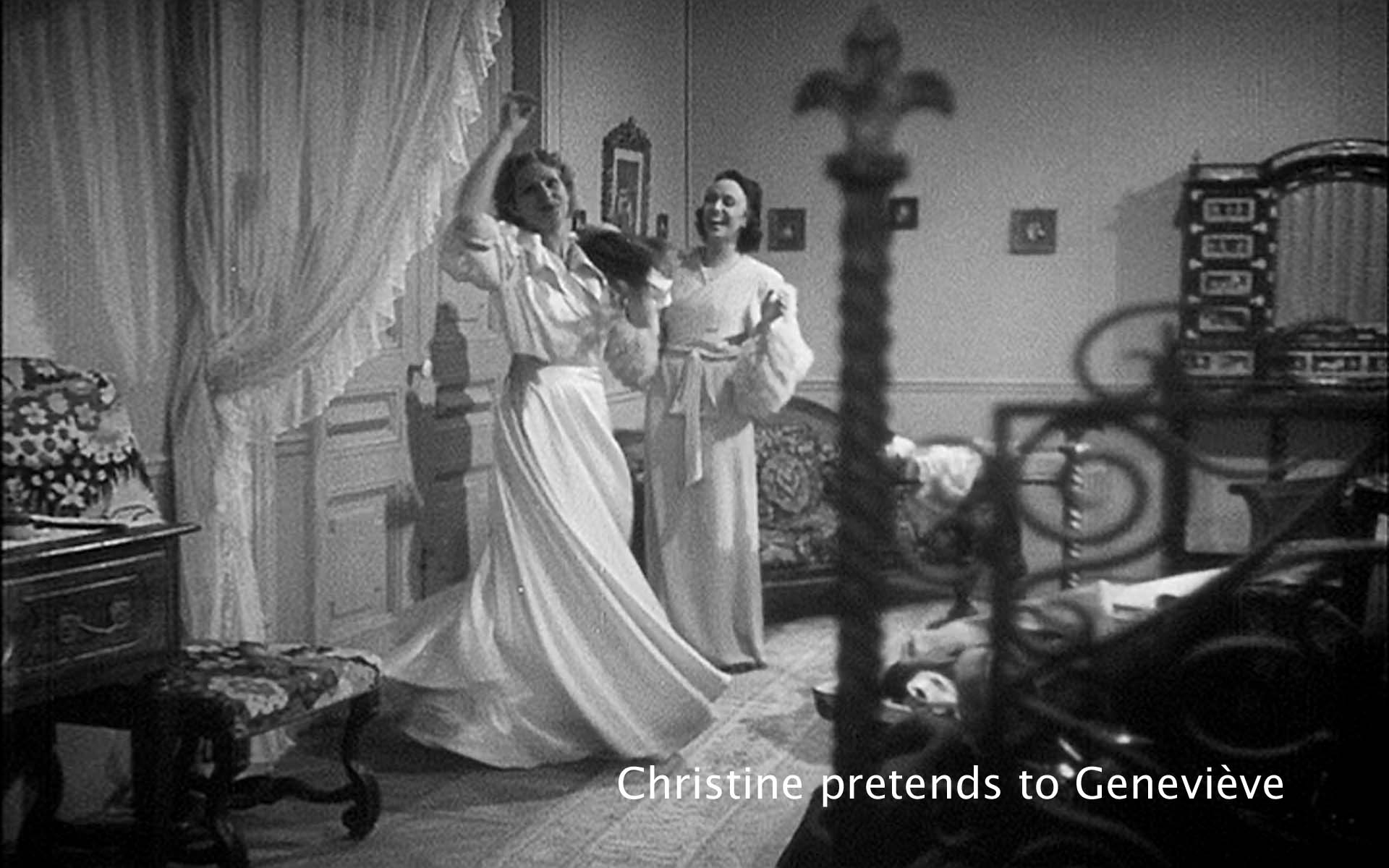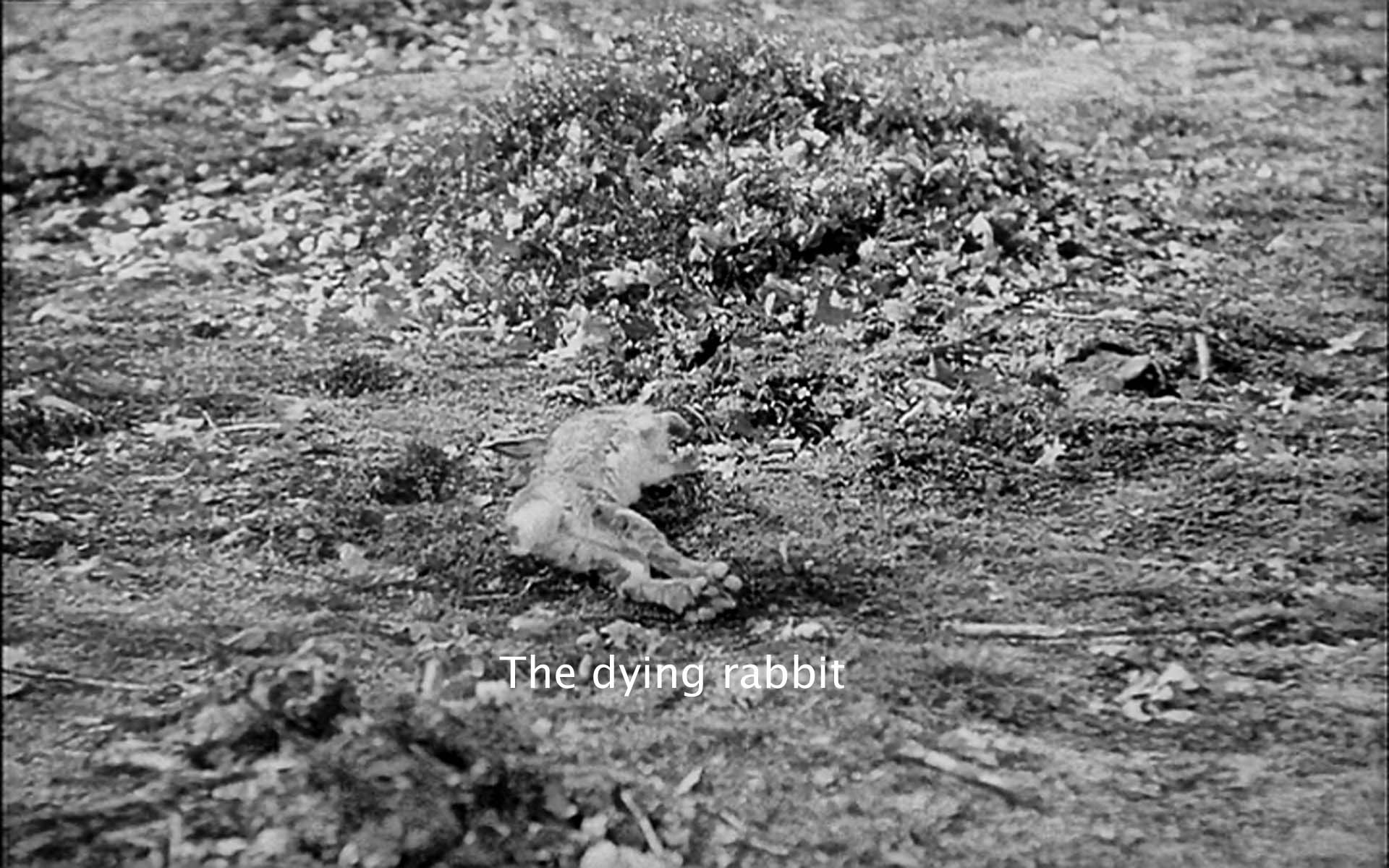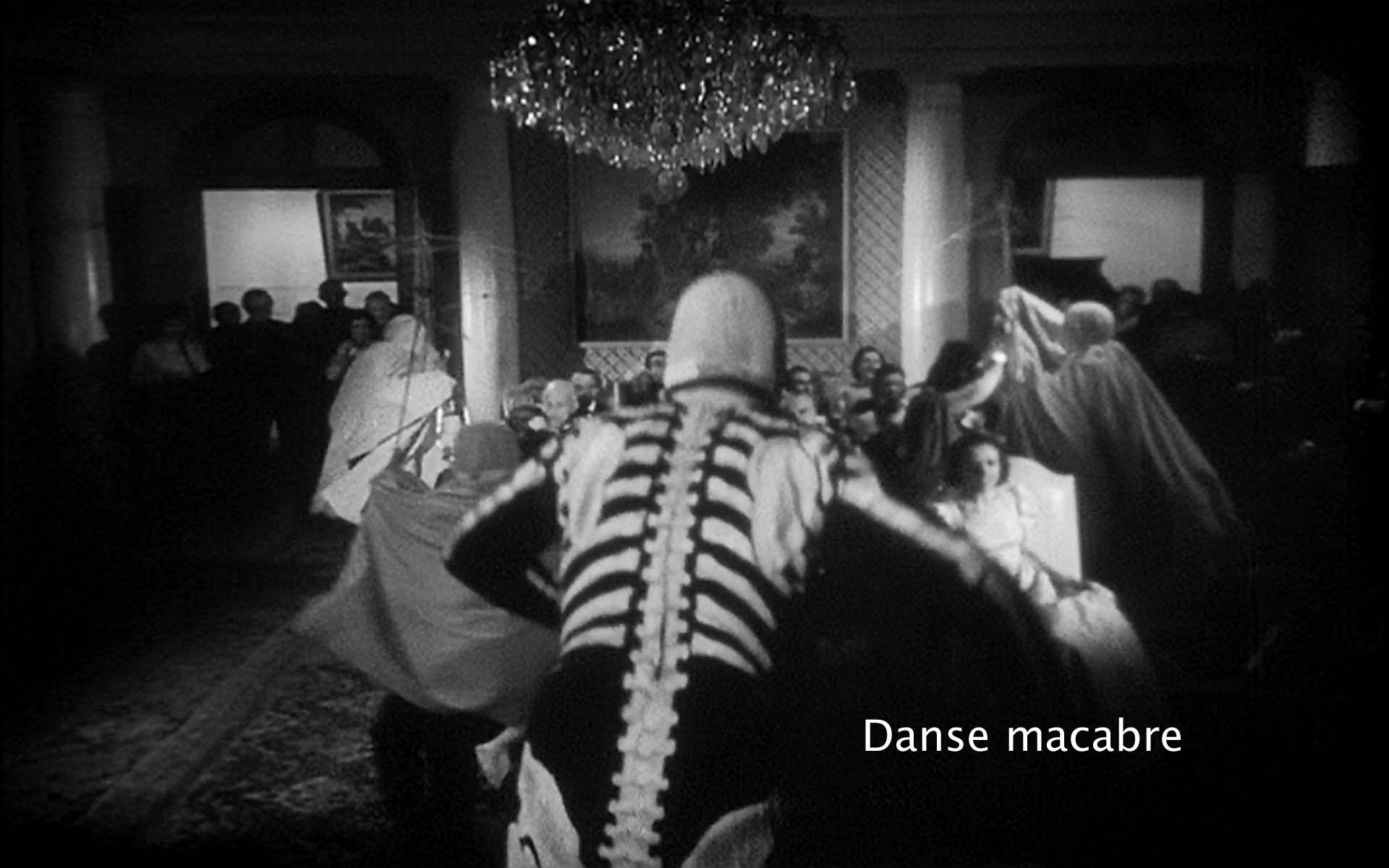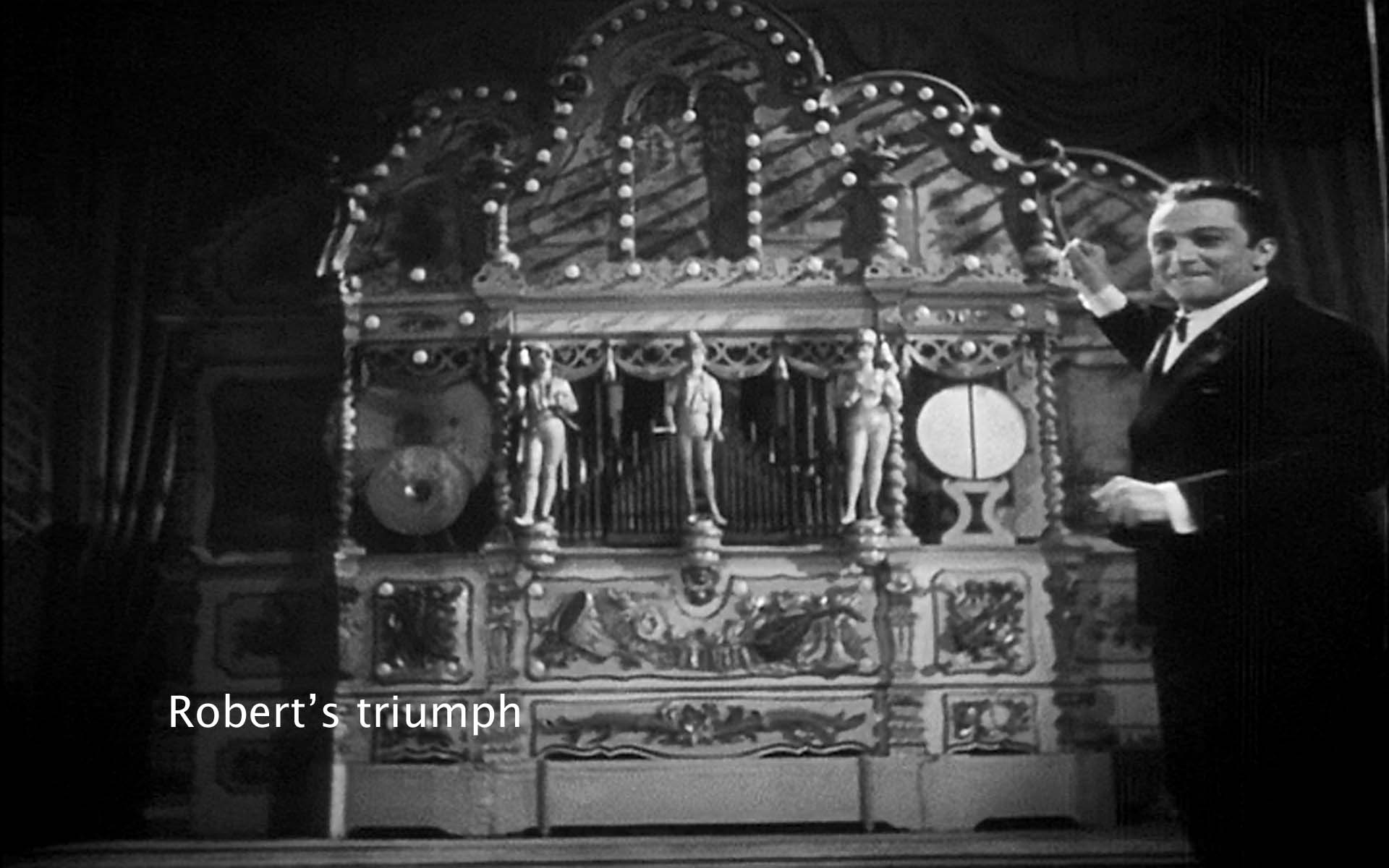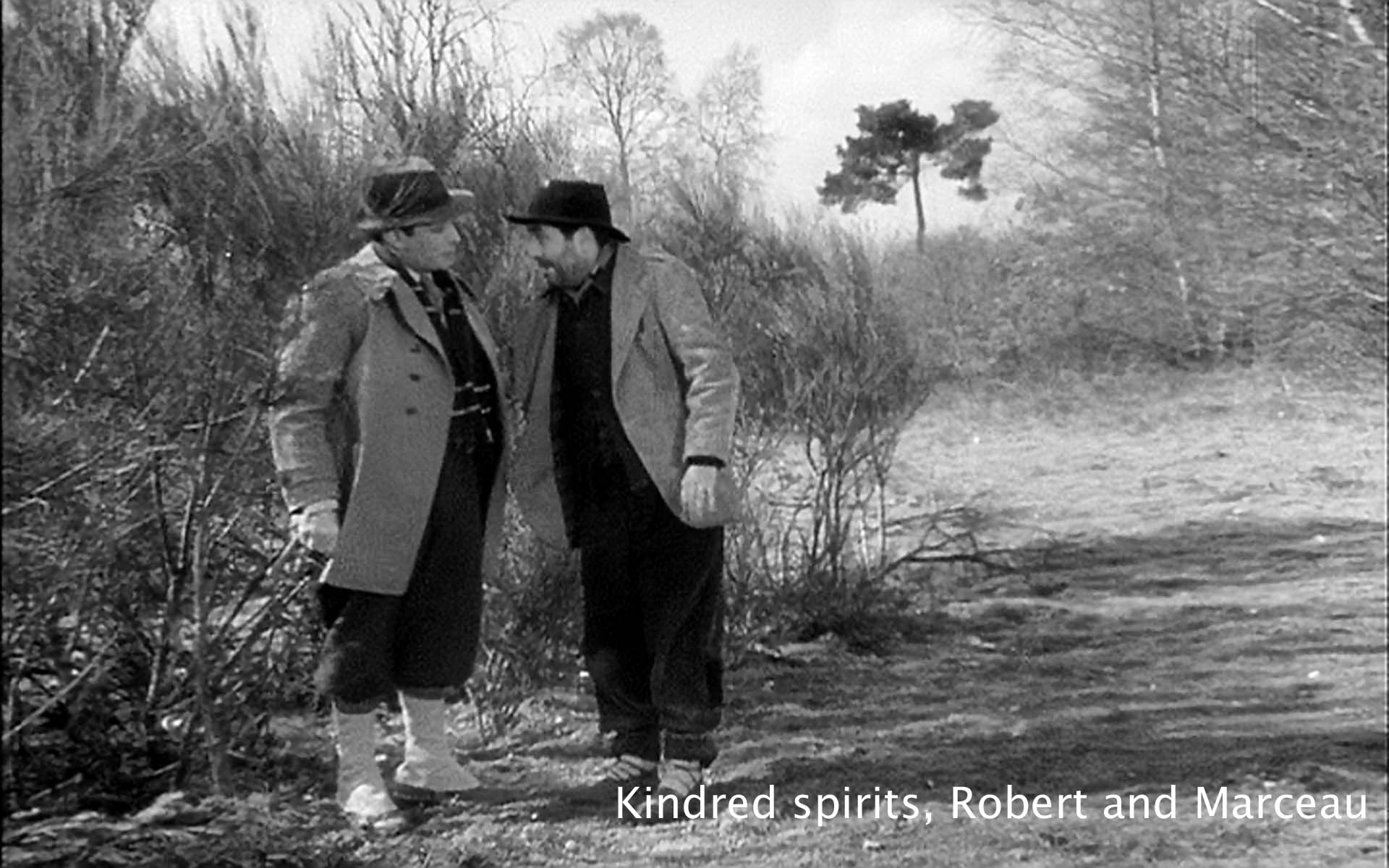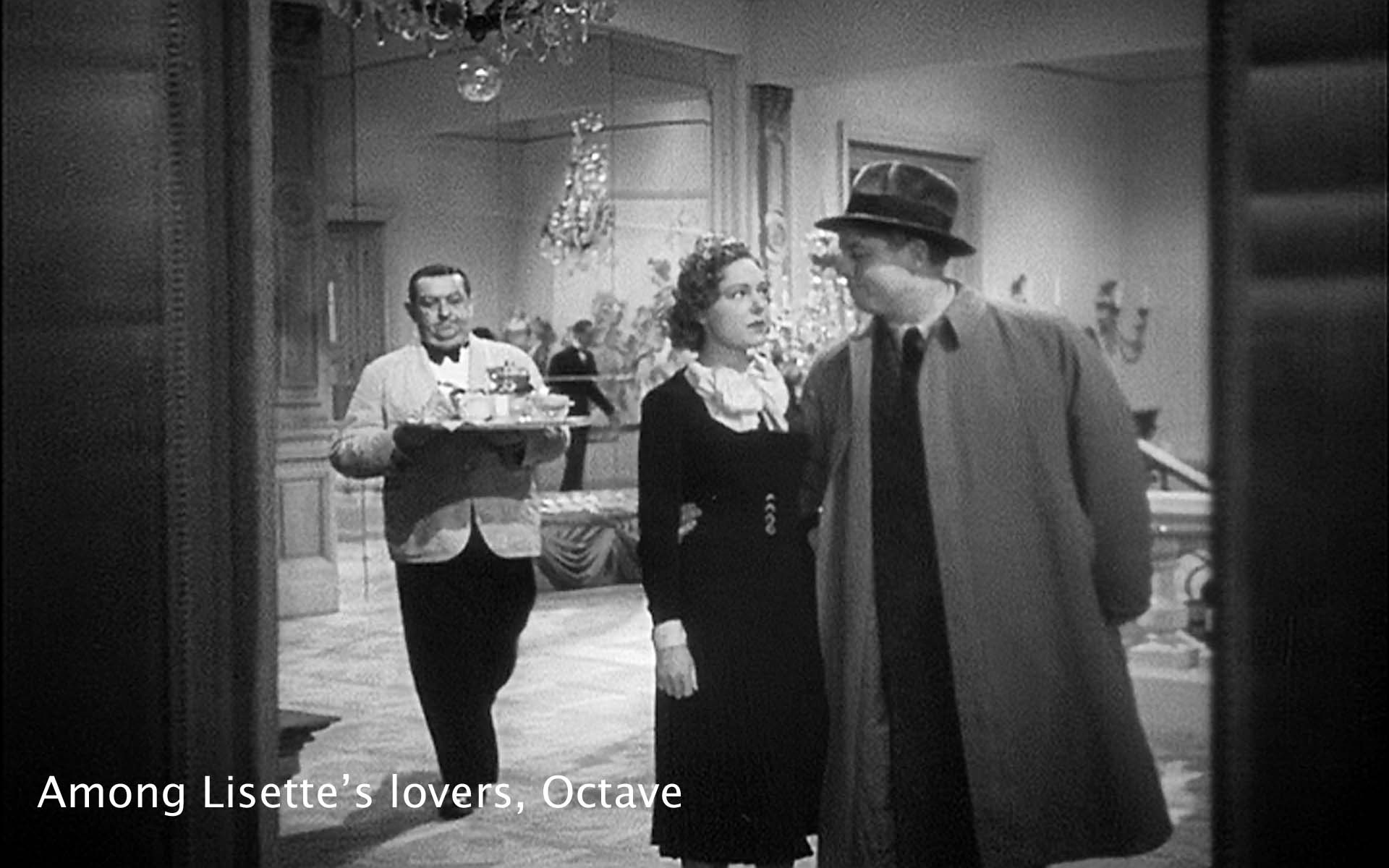There are two movies you’re likely to find on every ten best list you’ll ever see. Citizen Kane is one. This is the other. Yet I feel this is a hard movie to like. When I first saw it, it seemed to me chaotic, unstructured, not coming to a focus. And I get that feeling every time I see it again. I have to, as it were, re-learn this movie each time I view it.
Nevertheless, I think this is, quite simply, one of the two or three greatest movies ever made, and so say the critics and cinéastes in general. In it, as in all even merely good movies, the opening scene sets the motifs, like the opening of a symphony.
The very first thing we see is a radio transmitter, a machine, and machines are one of the important symbols in this film. From the transmitter comes a wire, and at the end of the wire is a radio announcer. She has come to Le Bourget airport to tell her radio audience about the arrival of a French hero, André Jurieu (Roland Toutain), who has just flown the Atlantic in a record-breaking 23 hours. Around her is a chaotic mob of people rushing to hail this new hero. And there you have it all, all the themes around which Jean Renoir built his movie.
You have the solitary, in this instance heroic and romantic, individual. But you also have the mobs and wires and transmitter that connect him and us to other people. Communication is one theme. Hell, said Sartre, is other people, and so it will prove in La Règle du Jeu. (The French name is the more severe for being singular: the rule of the game.)
The game is the game of human relationships, and the rule is absolute. A cabinet minister’s flunky greets and congratulates the pilot on behalf of the minister. Unfortunately, the minister himself could not come—he says. People will fall short; they will disappoint you and frustrate you. They will lie and pretend.
Asked by the radio reporter about his great flight, our pilot, André, says, “It wasn’t me, it was the plane.” (Another machine.) Our brave pilot now immediately breaks one of the rules. He announces to the multitudes listening to the radio that he is not happy and triumphant but miserable. He made his flight, he tells the listening millions, for a woman, and she did not even show up at the airport.
The rule of the game that he violates is: you must not disclose, you must not announce, you must not act on your real feelings.
The rest of the film deals with André’s pursuit of that woman, Christine (Nora Grégor), the Austrian wife of Robert de la Chesnaye (Marcel Dalio). (The “de” tells us he is of the very, very upper class. Also husband and wife address each other by the French “vous,” the formal “you,” another aristocratic mannerism.) The film cuts from André’s tactless speech at the airport to a radio in Christine’s bedroom transmitting that speech. This rich lady is innocent herself, for she is the daughter of a symphony conductor and has the sincerity of an artist. Her Austrian accent sets her apart from the others in this film (and evoked boos at the film’s first showing). But prompted by André’s declaration, she asks her sassy maid, Lisette (Paullette Dubost), what it’s like to have lovers. After Lisette’s playful, “Parisian” description, casually wanton, Christine goes into her husband’s room. He is enjoying one of his mechanical toys, and he, again, casually, assures her that he is not jealous about André’s public devotion. (Jealousy is one of the things forbidden by the rules of this cool, casual aristocratic game.) Christine is immensely pleased and grateful.
But he, touched by her innocence and sincerity, rushes off to call “Geneviève.” Geneviève (Mila Parély), we discover, is and has been Robert’s mistress even before he married Christine, but Robert, now, inspired by Christine’s decency, tries to shake her off. Robert resolves to have a grand hunting party at his chateau, La Colinière. At this juncture, Octave appears, played by Jean Renoir himself. He is the bumbling, genial, clownish friend of André (and everyone else); upper-class but poor, he lives off the hospitality of his rich friends. Octave persuades Christine and Robert to invite André to the chateau.
Christine and Robert are driven to the chateau to prepare things. There, Schumacher (Gaston Modot), the stern, straitlaced Alsatian gamekeeper, asks for the second time that Lisette, who is his wife, be allowed to stay permanently with him at the chateau. Robert puts him off and instead strikes up a friendship with Schumacher’s enemy, Marceau, the poacher (Julien Carette). A poacher is someone who breaks the rules, and, as such, Robert immediately takes a fancy to Marceau as a kindred spirit. He gives him a job as a footman at the chateau, much to Schumacher’s chagrin. (Robert addresses Marceau, and I believe he is the only person Robert so addresses, with “tu,” the “you” reserved for intimates.)
At the chateau, Christine and Robert are joined by more of their rich, aristocratic, and frivolous set as well as Geneviève. André and Octave arrive, and Christine makes a graceful speech designed to rule out any suspicion of hanky-panky between herself and André. We also learn that Jackie, Christine’s young niece, loves André, but he does not love her.
At this point, Renoir has established two classes in the film, upstairs and downstairs. The servants downstairs mimic the snobberies and prejudices (particularly the anti-semitism) of their masters upstairs—and their infidelities. The poacher Marceau begins flirting with Lisette, who is quite receptive. Upstairs, Robert proposes, to his guests’ delight, a masquerade in honor of André. As if the rules of this aristocratic game did not provide enough masking and pretense!
Next morning, the hunt begins, giving us another set of rules. A virtuoso piece of filming it is, with Renoir using ever more rapid cutting from shot to shot. He focuses on the wild life, the “game” (pun does not hold in French) being destroyed in this “game” by machines—now the guns. Particularly poignant is the last, lingering shot, of a rabbit giving one final kick of a leg and dying. The hunt stands for the idea of pursuit that pervades the film: out of love the characters pursue one another, but the pursuit ends in death—as the film will.
After these killings, and some squabbling about who was breaking the rules of the hunt (analogous to the rules for love affairs), the hunting party breaks up. André tells Jackie he only loves Christine (using “tu” to say it). A group begins looking at nature through a field glass—more machines and connections, intimacy which is really distance. Through the glass, Christine accidentally spots Robert and Geneviève embracing. (Ironically, it is a farewell embrace.) That night, before the masquerade, Christine, pretending gaily to accept Robert’s having a mistress, gets Geneviève to admit that she and Robert have sex. Meanwhile, downstairs, Marceau continues his seduction of the altogether willing Lisette despite Schumacher’s furiously discovering and threatening them.
At the party, Robert and all the rest put on a variety of costumes and disguises—skits. One skit is a danse macabre, a mockery of death. Offstage, Christine throws herself at one of the guests, Saint-Aubin, a man she does not care for. André pursues her and fights Saint-Aubin, while Schumacher, gun in hand, pursues Marceau. A mad chase ensues, with fistfights between André and Saint-Aubin, André and Robert, Schumacher’s rushing through the party, firing his revolver, and Christine’s going from Saint-Aubin to André to Octave as she tries to leave Robert. And then there is the final killing.
As in the ancient Greek ritual of the pharmakon, someone has been sacrificed. In Greek, the word means both poison and, if taken in the right dosage, antidote. Someone was selected—a scapegoat, as we say—and the sins of the community were projected onto that individual who was then exiled or killed. Thereby the community rid itself of evils that were blocking its continued existence. In a way, Rules of the Game re-enacts that primeval fertility rite. In a way.
Throughout all this action, Renoir gives us symbolic shots of machines. And “machines” or “the mechanical” include not only André’s airplane and Robert’s mechanical toys but radios, cars, guns, rabbit snares, a player piano—ultimately, the gun in the final murder. The mechanical contrasts with the sincere emotions of Christine, André, Octave, Jackie, and Schumacher. You could read this film as simply the conflict between the mechanical and inorganic, on the one hand, and, on the other, the vital and organic and heartfelt. (This was the dominant idea of a great French philosopher of Renoir’s era, Henri Bergson.)
You could also read this film as contrasting insiders and outsiders. The insiders are these rich aristocrats who play by a complicated set of rules (symbolized by recurring card games), an etiquette that rules out the frank expression of emotion. “Love as it exists in society,” Geneviève tells us, “is merely the mingling of two whims (fantaisies) and the contact of two skins (épidermes).” And the insiders are downstairs as well as up.
The outsiders include most obviously André. André, hero though he may be, embarrasses his lady love by complaining on the radio that she did not come to meet him when he completed his great flight. Half suicidal, he crashes his car, nearly killing himself and Octave. Octave, out of friendship, gets André invited to the chateau, thereby setting up the final catastrophe. And it is Octave who fails to take Christine away in the final scenes. Then there is the chaste and aspiring Christine herself. In her emotional turmoil, however, she turns utterly corrupt, offering herself to, first, the oily Saint-Aubin, then Octave, then André. Jackie the college girl with her crush on André creates little bits of embarrassment and chaos, here and there.
Finally, there is Schumacher. He is surely the image of romantic emotion run wild, when he runs crazily around the chateau, firing his revolver at Marceau, regardless of anyone else who might be in the way. And it is Schumacher who, out of jealousy, fires the final, fatal shot.
Romantics are a pain. Idealists are a pain. These outsiders, the romantics and idealists who do not play the game, cause trouble. Sometimes they do so from the noblest of motives, like Octave, sometimes from possessiveness, like André or Schumacher. By contrast, there is much to be said for a smooth-running, almost mechanical, social order, even with the lies and pretenses and inhibitions necessary to keep it running smoothly. Yet those lies and pretenses, that stifling of honest emotion, is repulsive. When André refuses to run away with Christine without “talking it over” with his host, “a man who shakes my hand,” she is appalled at this latest form of social hypocrisy.
There is another way that you can think about the insiders and outsiders, in the film’s contrasting the world of nature and the worlds of civilization, the fields and the greenhouse at La Colinière as opposed to the luxurious Paris house or the chateau. Traditionally, many comedies have a certain ritual at its core (for example, in Midsummer-Night's Eve or As You Like It). Characters leave the world of the city or court to mix things up in the country, traditionally termed "the green world." Finally, things get straightened out and the characters return to society. Renoir deliberately drew on a long French comic tradition, one play in particular by Musset, but a long series of comedies from Beaumarchais, Marivaux, Molière, and many others. It is a tradition with roots in the ancient fertility rituals that gave rise to the long line that runs from Greek comedy to Roman to commedia dell'arte to Molière and into our own time.
The characters in Rules of the Game leave Paris for the green world of La Colinière. There two characters bring the confusions of the green world right into the social world: Marceau, the poacher and lothario (a kind of Pan or satyr), and Octave, thrashing around in his bear suit. Bringing the green world into the social world leads, here, to all kinds of trouble: Christine's disillusionment and Schumacher's revenge. And when the characters go out to the greenhouse (that shot of the frog!), the result is not comic, but tragic. The “natural men” must be banished and the existing order restored.
You could read this film as bringing outsiders (Jurieu, Octave, Marceau) into the castle of the insiders, and then expelling them at the end. Or you could read this film as simply the contrast between the mechanical and the vital or between the mannered insiders and the straightforward outsiders or between the green world and the social world. But it seems to me all three of these readings are too simple (although you should keep them in mind). Renoir is too fine an artist for such simplifications.
Consider Marceau. A poisonous influence throughout, he is eager to join the corrupt, rule-bound world of the chateau as a house servant. (He likes the idea of wearing livery!) His flirtation with Lisette has nothing to do with the kind of purity of emotion that, with André and Christine, causes trouble. He wants to follow the same rules that the insincere aristocrats obey and the romantics have such trouble with. He outrages Schumacher by flirting with his wife in front of him, leading to Schumacher’s shooting up the chateau. When he does, Marceau tries to hide as a servant, seizing a tray to pass around. And in the finale he encourages Schumacher to shoot, resulting in the final killing.
Both Marceau and Octave represent yet another mythological figure, l'homme sauvage, homo silvaticus, or in Middle English, wodewose, the forest-man. Traditionally, he represents a connection between the world of civilization and the uncontrolled spirits of nature. (Think of Puck in Midsummer Night's Dream or the trickster of Native American myth.) He is often represented as covered with hair, as with Octave’s bear suit. Renoir explored the character in an earlier film, Boudu Saved from Drowning. These two forest-men bring the disorder of the natural world into the civilized world of Robert's chateau. At the end, they must be exiled, ending the picture. These two, Octave and Marceau, symbolize the two unsatisfactory alternatives. One follows the rules, but cleverly manipulates them. The other never followed them at all. Both end in gloomy banishment. Whether you follow the rules or you don't, you are banished. You can't win.
In short, you cannot escape the two unsatisfactory alternatives of romantic emotion or mechanical etiquette. It seems to me that Renoir is driving at a deeper tragedy than the Romantic idea that the mechanical stifles the vital or that hypocritical insiders crush sincere outsiders. The deeper, more poignant tragedy is that neither works. We cannot survive in a social world ruled by emotion, but the alternative, a social world of stifling lies and mechanical rules and pretenses, repels us. And Marceau’s story shows that you can’t evade these two painful alternatives. You can’t evade the rule, the domination, of the game. Renoir understands, as does Lisette when she persuades Octave not to run off with Christine, that you can’t live that way. You have to play by the rules—the realities of life in society.
But that is awful. We long for the innocent and free expression of our emotions, but that way lies disaster. We need rules (pretenses, etiquette, machines) for life to go on even though these social mechanisms corrupt. Accordingly, Renoir re-establishes that corrupt order at the end of the film when Robert lies about the murder.
Re-establishing social order—that is comedy, not tragedy. Renoir repeatedly said his film was légère, light, frivolous. He based The Rules of the Game loosely on a comedy by Musset, and he insisted he was writing in the long French tradition of social comedy, plays by Beaumarchais, Marivaux, Feydeau, and even Molière. Indeed, the film uses many of the plot devices of those comedies.
Social mechanisms corrupt. Yet we have to have them. I come back to Sartre’s maxim from No Exit: “l’enfer, c’est les autres,” Hell is other people. We humans are social animals (unlike the animals killed singly in the hunt). We, as humans, must live with other people and play by the rules. We cannot get out of the game, yet we cannot win it, either. That is “the rule of the game,” and it does indeed rule our lives in this comic, but tragic way. The Rules of the Game stands as a magnificent tribute to the French sense of irony.
